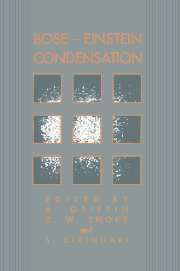Book contents
- Frontmatter
- Contents
- Preface
- Preface to paperback edition
- 1 Introduction: Unifying Themes of Bose–Einstein Condensation
- Part one Review Papers
- 2 Some Comments on Bose–Einstein Condensation
- 3 Bose–Einstein Condensation and Superfluidity
- 4 Bose-Einstein Condensation in Liquid Helium
- 5 Sum Rules and Bose–Einstein Condensation
- 6 Dilute-Degenerate Gases
- 7 Prospects for Bose–Einstein Condensation in Magnetically Trapped Atomic Hydrogen
- 8 Spin-Polarized Hydrogen: Prospects for Bose–Einstein Condensation and Two-Dimensional Superfluidity
- 9 Laser Cooling and Trapping of Neutral Atoms
- 10 Kinetics of Bose–Einstein Condensate Formation in an Interacting Bose Gas
- 11 Condensate Formation in a Bose Gas
- 12 Macroscopic Coherent States of Excitons in Semiconductors
- 13 Bose–Einstein Condensation of a Nearly Ideal Gas: Excitons in Cu2O
- 14 Bose–Einstein Condensation of Excitonic Particles in Semiconductors
- 15 Crossover from BCS Theory to Bose–Einstein Condensation
- 16 Bose–Einstein Condensation of Bipolarons in High-Tc Superconductors
- 17 The Bosonization Method in Nuclear Physics
- 18 Kaon Condensation in Dense Matter
- 19 Broken Gauge Symmetry in a Bose Condensate
- Part two Brief Reports
- Appendix. BEC 93 Participant List
- Index
15 - Crossover from BCS Theory to Bose–Einstein Condensation
Published online by Cambridge University Press: 15 December 2009
- Frontmatter
- Contents
- Preface
- Preface to paperback edition
- 1 Introduction: Unifying Themes of Bose–Einstein Condensation
- Part one Review Papers
- 2 Some Comments on Bose–Einstein Condensation
- 3 Bose–Einstein Condensation and Superfluidity
- 4 Bose-Einstein Condensation in Liquid Helium
- 5 Sum Rules and Bose–Einstein Condensation
- 6 Dilute-Degenerate Gases
- 7 Prospects for Bose–Einstein Condensation in Magnetically Trapped Atomic Hydrogen
- 8 Spin-Polarized Hydrogen: Prospects for Bose–Einstein Condensation and Two-Dimensional Superfluidity
- 9 Laser Cooling and Trapping of Neutral Atoms
- 10 Kinetics of Bose–Einstein Condensate Formation in an Interacting Bose Gas
- 11 Condensate Formation in a Bose Gas
- 12 Macroscopic Coherent States of Excitons in Semiconductors
- 13 Bose–Einstein Condensation of a Nearly Ideal Gas: Excitons in Cu2O
- 14 Bose–Einstein Condensation of Excitonic Particles in Semiconductors
- 15 Crossover from BCS Theory to Bose–Einstein Condensation
- 16 Bose–Einstein Condensation of Bipolarons in High-Tc Superconductors
- 17 The Bosonization Method in Nuclear Physics
- 18 Kaon Condensation in Dense Matter
- 19 Broken Gauge Symmetry in a Bose Condensate
- Part two Brief Reports
- Appendix. BEC 93 Participant List
- Index
Summary
Abstract
This article gives a detailed review of our current theoretical understanding of the crossover from cooperative Cooper pairing to independent bound-state formation and Bose–Einstein condensation in Fermi systems with increasing attractive interactions.
Introduction
There are two well-known paradigms for understanding the phenomena of superconductivity and superfluidity:
(I) BCS theory [1], in which the normal state is a degenerate Fermi liquid that undergoes a pairing instability at a temperature Tc ≪ εf, the degeneracy scale. The formation of Cooper pairs and their condensation (macroscopic occupation of a single quantum state) both occur simultaneously at the transition temperature Tc.
(II) Bose–Einstein condensation (BEC) of bosons at a Tc of the order of their degeneracy temperature. At a fundamental level these bosons (for example, 4He or excitons) are invariably composite objects made up of an even number of fermions. The composite particles form at some very high temperature scale of the order of their dissociation temperature Tdissoc, and these “pre-formed” bosons then condense at the BEC Tc ≪ Tdissoc.
In most cases of experimental interest the system under consideration clearly falls into one category or the other. For instance, 3He is a Fermi superfluid described by (I) whereas 4He is a Bose superfluid (II). Essentially all cases of superconductivity in metals that we understand reasonably well are much closer to (I) than to (II), as evidenced by the existence of fermionic quasiparticles above Tc.
- Type
- Chapter
- Information
- Bose-Einstein Condensation , pp. 355 - 392Publisher: Cambridge University PressPrint publication year: 1995
- 119
- Cited by

